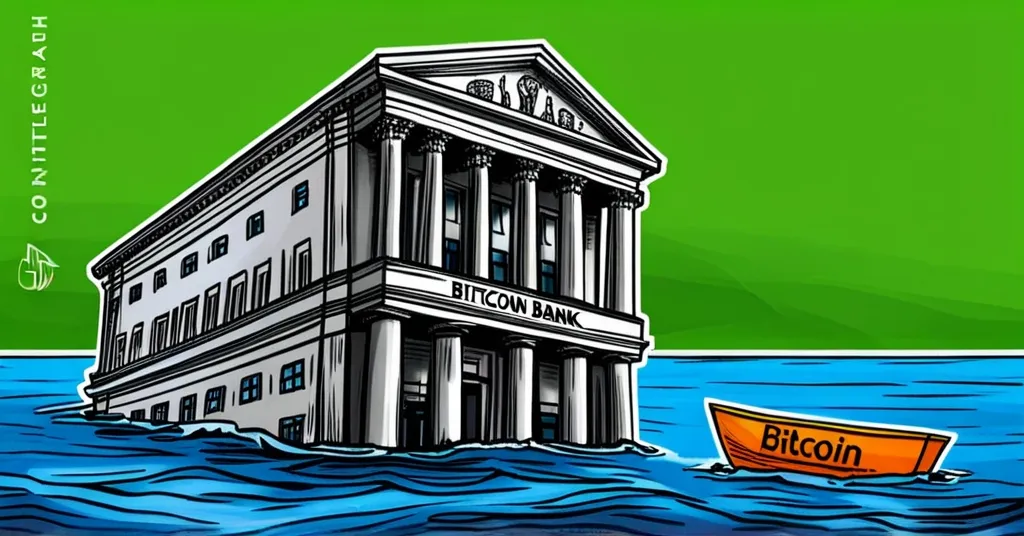S&P Global Predicts $850 Billion Bank Credit Losses in 2025: Crypto as an Alternative

$850 Billion in Credit Losses Looming Over Banks in 2025, S&P Global Warns
Banks worldwide are bracing for a staggering $850 billion in credit losses in 2025, according to S&P Global. Despite an overall improving economic situation, the global banking sector faces significant challenges, with potential impacts reaching beyond traditional finance into the world of cryptocurrencies.
- $850 billion in credit losses predicted for 2025
- Factors include slowing economic activity and potential inflation
- Impact on traditional banking and cryptocurrencies
S&P Global’s Forecast
S&P Global’s Global Credit Outlook 2025 report forecasts a 7% increase in credit losses for banks. This forecast comes despite the expectation that major economies will achieve soft landings and central banks will ease monetary policies. A soft landing refers to a gradual economic recovery without major disruptions, while monetary policy easing involves lowering interest rates to stimulate borrowing and spending. S&P Global, a leading financial analytics firm renowned for its accurate forecasting, emphasizes that even with these supportive conditions, the path to recovery is fraught with potential pitfalls.
Key Risks and Challenges
The report identifies several key risks that could exacerbate the situation. Slowing economic activity, the threat of resurgent inflation, and political polarization are highlighted as significant factors that could lead to sustained bouts of market volatility. In the United States, proposed economic policies, such as higher tariffs under President-elect Donald Trump, could trigger inflation, potentially forcing the Federal Reserve to reconsider its strategy of monetary policy easing. Higher tariffs mean increased taxes on imports, which can drive up prices for consumers and businesses alike. For more detailed insights on the impact of higher tariffs on inflation and credit conditions, refer to S&P Global’s specialized reports.
“We forecast global credit losses will increase about 7%, to $850 billion, in 2025 – within our base case at current rating levels for most banks.”
Impact on Traditional Banking
Despite these looming challenges, there’s a glimmer of hope as eight out of ten banking groups currently enjoy stable ratings outlooks. This stability suggests that banks have some resilience, but the road ahead remains uncertain. Financial institutions will need to navigate these choppy waters with caution, focusing on strengthening their balance sheets and managing their loan portfolios effectively. Overdue loans, or delinquent loans, will be a critical area of concern, as they directly contribute to the anticipated credit losses. For insights into strategies for banks to manage credit losses, refer to the latest regulatory guidance.
Bitcoin and Cryptocurrencies as Alternatives
While traditional banks face these challenges, the decentralized nature of cryptocurrencies offers an alternative path forward. Bitcoin, with its fixed supply and resistance to inflationary pressures, stands as a beacon of stability in an otherwise turbulent financial landscape. Its fixed supply means there will only ever be 21 million bitcoins, which contrasts sharply with fiat currencies that can be printed without limit. The potential for increased market volatility could impact the price of bitcoin and other cryptocurrencies, but the resilience of blockchain technology and the growing adoption of decentralized finance (DeFi) solutions offer hope for a more robust and inclusive financial system.
Yet, it’s not all sunshine and rainbows in the crypto space. The same market volatility that could challenge traditional banks might also cause significant fluctuations in cryptocurrency prices. However, for those who believe in the power of decentralization and the principles of effective accelerationism, the potential for disruption and innovation remains a compelling draw. For a deeper understanding of the impact of inflation on cryptocurrencies, explore community insights.
Counterpoints and Perspectives
Despite S&P Global’s dire forecast, some experts believe the banking sector may fare better than predicted. They argue that banks have learned from past crises, such as the 2008 financial meltdown, and are better prepared to manage credit losses. In the crypto world, critics point out that while Bitcoin offers a hedge against inflation, it is not immune to market volatility and could face its own set of challenges in 2025.
It’s worth considering that the Federal Reserve’s approach to monetary policy might be more nuanced than a straightforward halt or reversal of easing. Brett House from Columbia Business School suggests that the Fed is adopting a cautious, data-dependent strategy, which could provide some stability amidst the uncertainty.
Future Outlook and Strategies
As we navigate the uncertainties of the coming year, maintaining a balanced perspective is crucial. Traditional banks should focus on strengthening their balance sheets and managing risk effectively. Crypto enthusiasts, on the other hand, should monitor market trends closely and consider diversifying their investments to mitigate potential volatility. Diversification in the crypto space might mean exploring other cryptocurrencies like Ethereum or delving into DeFi platforms, which offer different risk-reward profiles.
While the traditional financial system grapples with its vulnerabilities, the decentralized nature of cryptocurrencies continues to innovate and adapt. Bitcoin maximalists might see this as an opportunity for Bitcoin to shine as a store of value, but it’s important to acknowledge that altcoins and other blockchain technologies also have roles to play in this financial revolution.
Key Questions and Takeaways
- What is the predicted amount of credit losses for banks in 2025?
S&P Global forecasts that banks will face up to $850 billion in credit losses in 2025.
- What factors does S&P Global identify as potential headwinds for global credit conditions?
S&P Global identifies slowing economic activity, the prospect of resurgent inflation, and political polarization as potential headwinds.
- How might the proposed economic plans of Donald Trump affect credit conditions?
The proposed plans, including higher tariffs, could trigger inflation, which might force the Federal Reserve to halt or reverse its monetary policy easing, posing a significant risk to credit conditions.
- What is the overall outlook for global credit conditions in 2025?
The overall outlook is supportive, with major economies expected to achieve soft landings and central banks easing monetary policies, yet the path to improvement is narrow due to overlapping risks.
- How can Bitcoin and cryptocurrencies serve as alternatives during economic uncertainty?
Bitcoin’s fixed supply and resistance to inflationary pressures make it a potential hedge against economic instability. The growing adoption of DeFi solutions offers new financial opportunities.
- What strategies should banks and crypto enthusiasts adopt to prepare for 2025’s financial landscape?
Banks should focus on strengthening their balance sheets and managing risk effectively. Crypto enthusiasts should monitor market trends closely and consider diversifying their investments.



